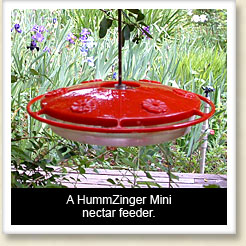Feeding Hummingbirds
 When it comes to turning a backyard into a bird sanctuary, many fledgling birders get their start by feeding the smallest of our feathered friends, the hummingbird. Here in the Sacramento Valley, Anna’s Hummingbirds are year-round residents, while Black-chinned hummers prefer to winter in warmer climes, then return to the area in early spring. Rufous hummingbirds make a brief but dramatic pit stop as they pass through on their migratory journey, often claiming a feeder and brashly defending it during its short stay.
When it comes to turning a backyard into a bird sanctuary, many fledgling birders get their start by feeding the smallest of our feathered friends, the hummingbird. Here in the Sacramento Valley, Anna’s Hummingbirds are year-round residents, while Black-chinned hummers prefer to winter in warmer climes, then return to the area in early spring. Rufous hummingbirds make a brief but dramatic pit stop as they pass through on their migratory journey, often claiming a feeder and brashly defending it during its short stay.
While the Anna’s and Black-chinned look similar, the color of their gorget (or throat patch) is a dead giveaway to their identification. Anna’s gorgets have a pinkish magenta hue, while the Black-chinned’s are more purplish, like the color of grape soda. Rufous are easily identified by their light brown feathers and the dazzling copper flash of their gorget. Body shape can also help in identification—Black-chinned are a bit more tall and slender than the average Anna’s, while Rufous tend to be the shortest and stockiest of the three.
Despite their differences, all three can be enticed to your patio by a nectar feeder filled with fresh sugar water. Let’s talk briefly about feeders. Sure, you can get by with a dime-store hummingbird feeder, the ones that resemble a high school chemistry experiment gone wrong. They usually feature a glass tube that extends outward, often with a flower or “bee guard” attached to the end of it. The problem with these bargain basement feeders is that they drip. Incessantly. More sugar solution winds up on the ground beneath the feeder than in any hummer’s belly. They’re also difficult to clean, requiring the employment of a tiny bottle brush and plenty of patience to hit every spot. And clean it you must. Bacteria allowed to grow in a hummingbird feeder can take its toll on our little dinner guests. Better to have no feeder than a dirty feeder.

Wild Birds & Gardens carries a dizzying array of hummingbird feeders. My personal recommendation is the HummZinger line of feeders, available in a wide range of sizes and prices. Not only are they attractive and practically indestructible, but they’re incredibly simple to keep clean. Shaped more like a cherry pie than a hamster feeder, the top easily pops off to make fast work of cleaning them. You can even stick ‘em in the dishwasher. It may be a bit of a luxury, but I keep two on hand and swap out a clean one while the old one awaits the next dishwasher cycle.
To prevent ants from being your primary dinner guest, you might pick up what’s known as an “ant guard” (also known as an “ant moat”). These clever inventions serve as a barrier between the ant and the feeder. You hang the ant guard on your hook, then hang your feeder on the aunt guard. In my experience, these little devices are extremely effective and can last several seasons. Wild Birds & Gardens carries several different models.
Now let’s get down to the real reason the hummers are visiting in the first place—the sugar water solution. The standard recipe for hummingbird chow is one part sugar to four parts water. For example, add a quarter cup of sugar to one cup of water and you’re good to go. You can make this process a snap by stopping by Wild Birds & Gardens and picking up some Songbird Essentials fine-grain sucrose. This highly-refined sugar can be dissolved in cold water, making the steamy chore of boiling water, adding the sugar, and letting it cool before filling your feeders a thing of the past! From breaking out your tablespoons to hanging the feeder, the entire task can be completed in less than five minutes! You’re welcome.
A brief word on red dye or food coloring: Skip it! Hummingbirds don’t need their dinner to be stained red in order to zero in on it. The red color of the feeders themselves already helps them locate their next meal, and the dye can be harmful to a bird’s sensitive digestive tract. And as mentioned earlier, keep those feeders clean and the sugar solution fresh! Swap it out at least once a week, more often in warm weather.
So there you have it, tips on keeping your hungry hummers happy, healthy and the best-fed birds on the block.

